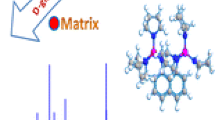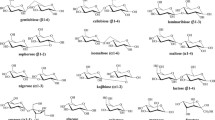Abstract
Comprehensive comparisons between three 1-aryl-3-methyl-5-pyrazolone (AMP) labeling reagents were carried out for the analysis of reductive monosaccharides using reversed phase high performance liquid chromatography diode array detection coupled to electrospray ionization mass spectrometry. AMP derivatives included 1-phenyl-3-methyl-5-pyrazolone (PMP), 1-(4-methoxyphenyl)-3-methyl-5-pyrazolone (PMPMP) and 1-(2-naphthyl)-3-methyl-5-pyrazolone (NMP). The separation of AMP-monosaccharides was found to be pH-dependent under reversed phase conditions and acceptable separations were obtained at pH < 4.5. The elution orders of AMP-aldoses were rationalized by geometric factors involved in the presence of hydroxyl groups at C2 and C3 positions of the saccharide moiety. When PMP or PMPMP were used as labeling agents Glucose and galactose were completely separated, while arabinose and xylose were observed to co-elute. The use of NMP revealed that arabinose and xylose could be separated while glucose and galactose were co-eluted. MS-MS data of AMP-monosaccharides gave characteristic fragment ions resulting from cleavage between the C2–C3 bond (m/z 373 for PMP derivatives, m/z 433 for PMPMP derivatives, and m/z 473 for NMP derivatives). Bond breakage between C1–C2 (m/z 359 for PMP derivatives, m/z 419 for PMPMP derivatives, and m/z 459 for NMP derivatives) of the saccharide moiety was also found to be characteristic for AMP-saccharides. Application to the analysis of hydrolyzed rape pollen polysaccharides revealed the presence of four unexpected monosaccharides, namely ribose, erythrose, threose and glyceraldehyde.







Similar content being viewed by others
References
Takemoto H, Hase S, Ikenaka T (1985) Anal Biochem 145:245–250
Rice KG, Takahashi N, Namiki Y, Tran AD, Lisi PJ, Lee YC (1992) Anal Biochem 206:278–287
Kondo A, Suzuki J, Kuraya N, Hase S, Kato I, Ikenaka T (1990) Agric Biol Chem 54:2169–2170
Huang L, Hollingsworth RI, Castellani R, Zipser B (2004) Glycobiology 14:409–416
Charlwood J, Birrell H, Gribble A, Burdes V, Tolson D, Camilleri P (2000) Anal Chem 72:1453–1461
Honda S, Akao E, Suzuki S, Okuda M, Kakehi K, Nakamura J (1989) Anal Biochem 180:51–357
Strydom DJ (1994) J Chromatogr A 678:17–23
Fu D, O’Neill RA (1995) Anal Biochem 227:377–384
Zhang L, Xu J, Zhang L, Zhang W, Zhang Y (2003) J Chromatogr B 793:159–165
Yang X, Zhao Y, Zhou S, Liu L, Wang H, Mei Q (2005) Chin J Anal Chem 33:1287–1290
Lv Y, Yang X, Zhao Y, Ruan Y, Yang Y, Wang Z (2009) Food Chem 112:742–746
Yang X, Zhao Y, Lv Y (2007) J Agric Food Chem 55:4684–4690
Guček M, Pihlar B (2000) Chromatographia 51:S139–S142
Honda S, Togashi K, Taga A (1997) J Chromatogr A 791:307–311
Honda S, Suzuki S, Taga A (2003) J Pharm Biomed Anal 30:1689–1714
Kakehi K, Suzuki S, Honda S, Lee YC (1991) Anal Biochem 199:256–268
Kakehi K, Ueda M, Suzuki S, Honda S (1993) J Chromatogr A 630:141–146
Castells CB, Arias VC, Castells RC (2002) Chromatographia 56:153–160
Tapie N, Malhiac C, Hucher N, Grisel M (2008) J Chromatogr A 1181:45–50
Ding C, Wang L, Tian C, Li Y, Sun Z, Wang H, Suo Y, You J (2008) Chromatographia 68:893–902
You J, Sheng X, Ding C, Sun Z, Suo Y, Wang H, Li Y (2008) Anal Chim Acta 609:66–75
Suzuki S, Kakehi K, Honda S (1996) Anal Chem 68:2073–2083
Shen X, Perreault H (1998) J Chromatogr A 811:47–59
Shen X, Perreault H (1999) J Mass Spectrom 34:502–510
Harvey DJ (2003) Int J Mass Spectrom 226:1–35
Yamamoto FM, Rokushika S (2004) Anal Chim Acta 501:143–149
Acknowledgements
This work was supported by the Hundred Talents Project of the Chinese Academy of Sciences (328) and the National Natural Science Foundation of China (20075016).
Author information
Authors and Affiliations
Corresponding author
Rights and permissions
About this article
Cite this article
Sun, Z., Song, C., Xia, L. et al. Comprehensive Comparisons between 1-Phenyl-3-methyl-5-pyrazolones, 1-(4-Methoxyphenyl)-3-methyl-5-pyrazolones and 1-(2-Naphthyl)-3-methyl-5-pyrazolones as Labeling Reagents Used in LC-DAD-ESI-MS-MS Analysis of Neutral Aldoses and Uronic Acids. Chroma 71, 789–797 (2010). https://doi.org/10.1365/s10337-010-1570-5
Received:
Revised:
Accepted:
Published:
Issue Date:
DOI: https://doi.org/10.1365/s10337-010-1570-5




